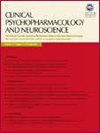Switching Antipsychotics to Blonanserin in Patients with Schizophrenia: An Open-label, Prospective, Multicenter Study
IF 2.4
4区 医学
Q3 NEUROSCIENCES
引用次数: 11
Abstract
Objective This study was performed to investigate the efficacy and tolerability of blonanserin in schizophrenic patients who were previously treated with other antipsychotics but, due to insufficient response, were switched to blonanserin. Methods A total of 52 patients with schizophrenia who were unresponsive to treatment with antipsychotic monotherapy or combination therapy were recruited into this 12-week, open-label, prospective, multicenter study. Patients were switched to blonanserin from their existing antipsychotics over a maximum 2-week tapering-off period. Efficacy was primarily evaluated using the 18-item Brief Psychiatric Rating Scale (BPRS). Assessments were performed at baseline, and at weeks 1, 2, 4, 8, and 12. Results Switching to blonanserin resulted in a significant decrease in the mean total score on the BPRS from baseline (56.8 ± 9.4) to week 12 (42.1 ± 13.8, p < 0.001). The most common adverse events were extrapyramidal symptoms (n = 12, 23.1%), insomnia (n = 10, 19.2%), and emotional arousal (n = 6, 11.5%). Overweight or obese patients (body mass index ≥ 23 kg/m2, n = 33) who switched to blonanserin exhibited significant weight loss from 75.2 ± 9.3 kg at baseline to 73.5 ± 9.2 kg at week 12 (p = 0.006). The total cholesterol (baseline, 236.1 ± 47.6 mg/dl; endpoint [week 12], 209.9 ± 28.0 mg/dl; p = 0.005) and prolactin levels (baseline, 80.0 ± 85.2 ng/ml; endpoint [week 12], 63.2 ± 88.9 ng/ml; p = 0.003) were also significantly improved in patients with hypercholesterolemia or hyperprolactinemia. Conclusion The results of the present study suggest that switching to blonanserin may be an effective strategy for schizophrenic patients unresponsive to other antipsychotic treatments.精神分裂症患者将抗精神病药物改为布兰色林:一项开放标签、前瞻性、多中心研究
目的探讨布隆那色林治疗精神分裂症患者的疗效和耐受性,这些患者先前使用其他抗精神病药物治疗,但由于疗效不足而改用布隆那色林。方法共招募52例对抗精神病药物单一或联合治疗无反应的精神分裂症患者,进行为期12周的开放标签、前瞻性、多中心研究。患者从现有的抗精神病药物中切换到blonanserin,最多2周的减量期。疗效主要采用18项精神病学简要评定量表(BPRS)进行评估。在基线和第1、2、4、8和12周进行评估。结果切换到blonanserin导致BPRS平均总分从基线(56.8±9.4)到第12周(42.1±13.8,p < 0.001)显著下降。最常见的不良事件是锥体外系症状(n = 12, 23.1%)、失眠(n = 10, 19.2%)和情绪唤醒(n = 6, 11.5%)。超重或肥胖患者(体重指数≥23 kg/m2, n = 33)改用blonanserin后,体重从基线时的75.2±9.3 kg显著减轻至第12周时的73.5±9.2 kg (p = 0.006)。总胆固醇(基线,236.1±47.6 mg/dl;终点[第12周],209.9±28.0 mg/dl;P = 0.005)和催乳素水平(基线,80.0±85.2 ng/ml;终点[第12周],63.2±88.9 ng/ml;P = 0.003)在高胆固醇血症或高泌乳素血症患者中也有显著改善。结论本研究结果提示,对于对其他抗精神病药物无反应的精神分裂症患者,改用blonanserin可能是一种有效的策略。
本文章由计算机程序翻译,如有差异,请以英文原文为准。
求助全文
约1分钟内获得全文
求助全文
来源期刊

Clinical Psychopharmacology and Neuroscience
NEUROSCIENCESPHARMACOLOGY & PHARMACY-PHARMACOLOGY & PHARMACY
CiteScore
4.70
自引率
12.50%
发文量
81
期刊介绍:
Clinical Psychopharmacology and Neuroscience (Clin Psychopharmacol Neurosci) launched in 2003, is the official journal of The Korean College of Neuropsychopharmacology (KCNP), and the associate journal for Asian College of Neuropsychopharmacology (AsCNP). This journal aims to publish evidence-based, scientifically written articles related to clinical and preclinical studies in the field of psychopharmacology and neuroscience. This journal intends to foster and encourage communications between psychiatrist, neuroscientist and all related experts in Asia as well as worldwide. It is published four times a year at the last day of February, May, August, and November.
 求助内容:
求助内容: 应助结果提醒方式:
应助结果提醒方式:


